GASTERIAS, ALOES AND HAWORTHIAS IN MY COLLECTION
Jozef Verhoeven (Belgium)
(e-mail fa030340@skynet.be)
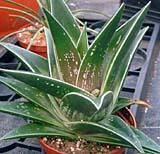
Photo 9. Aloe variegata 'Splash'
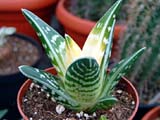
Photo 10. Variegated Aloe variegata
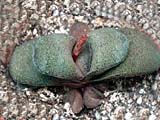
Photo 11. G. armstrongii x baylissiana
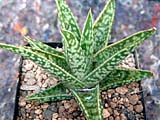
Photo 12. Gasteraloe Lily
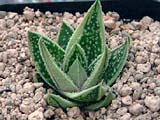
Photo 13. Gasteraloe Spirit of 88
-m.jpg)
Photo 14. Gasteraloe World Beauty (G. glomerata x A. parvula)
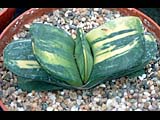
Photo 15. Variegated Gasteria nitida
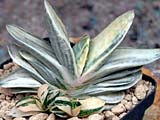
Photo 16. Variegated Gasteria sp. Ham1250
| | | | | | | |
My collection of plants consists mainly of Gasteria, Haworthia and Aloe and their hybrids. Most of them are cultivated in bimskies, but also in a mixture of soil and bimskies.
The full list of my collection you can find here: file XLS or file RTF.
In the winter period they are regularly watered, but beginning with March I water the plants using also a bit of manure substance. My plants are getting full sun, only in the summer period when it becomes too hot I use a net to protect the plants from getting burned. Both in winter and in summer, in short all the year round the greenhouse gets good ventilation. In July and August the plants have a rest period and therefore get almost no water.
Cross-pollination is sometimes made, and I have already succeeded to have some seeds, but sowing is not always a success.
I have among other things made a hybrid of Aloe 'Doran Black' x 'Lizard Lips', also Aloe parallelliflora x 'Lizard Lips'. It will succeed me sometimes. Recently I also had seeds of Aloe variegata with white flowers.
I try, however, make hybrids with Haworthias and sometimes they are successful.
I try also to propagate my plants from leaves, but I'm not always successful. It depends a little on the type.
Plants from genera Aloe, Gasteria and Haworthias are easy in cultivation if one keeps to some rules. In winter when the plants take a rest give them no water, sprinkling is possible. Beginning with March give them regular watering using a fertilizer. Remember that in July and August the plants have summer rest. Very good ventilation is especially important. Winter temperature around 5 or 6C is sufficient for the plants.
Below you can see some plants from my collection.
- Aloe 'Brass Hat' (Photo 2): one of John Bleck's hybrids, a small Aloe. The parents are (haworthioides x bakeri) x {(descoingsii x calcairophila) x bakeri}. When my plant has full sun it turns almost black. The flowers are small.
- Aloe 'Lysa' (Photo 4): a hybrid of D. Cumming, who has made some different hybrids. The parents are Aloe bakeri x variegata. It is also a small Aloe hybrid.
- Aloe 'Parjay' (Photo 5): also a hybrid of D. Cumming . The parents are unknown but must include descoingsii and parvula.
- Aloe 'Snowflake' x 'Doran Black' (Photo 7): A beautiful compact plant of two hybrids or Aloe rauhii. Beautiful white colour on thumbs with wart-like pattern. I keep these plants in light shade and give them regular watering with only a small quantity of fertilizer to keep them compact.
- Aloe rauhii x saundersieae (Photo 8): A small plant, doesn't need too much sun, better is grown in shade. It is rather sensitive, but should be watered and fertilized regularly.
- Gasteraloe 'World Beauty' (Photo 14): Very sensitive plant when it is too much sun, better grown a light shade. The parents are Gasteria glomerata and Aloe parvula, for this reason the plant has also a bluish hue on its thumbs.
- Haworthia cv. 'Pale Peace' (Photo 17): I think that the parents of this plant were H. truncata x pygmaea or retusa. This is a special variegated form that I have received from Rudolf Schultz from Tarrington in Australia. It's a nice plant and not so difficult in cultivation.
- Haworthia cv. 'Rasper' (Photo 18): Beautiful compact Haworthia, I suspect that its parents were Haw. emelyae v. major and Haw. truncata, but I am not certain. It has a wart-like appearance. It would be well to give it manure substance regularly, a little water and a small quantity of fertilizer. In my collection it stands in full sun.
- Haworthia truncata cv. 'Ivory Tips' (Photo 19): This is the plant I received from Tarrington under the name H. truncata x setata. If the plant has some full sun, it lets show why it has been named 'Ivory Tips', because the tips of the plant turn golden.
- Gasterworthia 'Flipper' (Photo 21): A very beautiful plant which I recommend to everyone. A young growth is silver-colored. The parents are certain to be Haworthia pygmaea and Gasteria sp. The plant if kept in full sun remains very compact then. May be economically fertilized and watered regularly.
- Aloe 'Jade Temple' (Photo 22): The parents of this plant are Aloe (somaliensis x rauhii) x dinteri. It is a beautiful compact plant. A must for everyone who want to cultivate small hybrids.
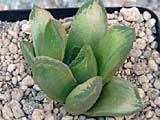
Photo 17. Haworthia. cv. 'Pale Peace'

Photo 18. Haworthia. cv. 'Rasper'
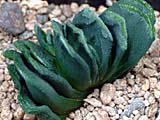
Photo 19. Haworthia. truncata cv. 'Ivory Tips'
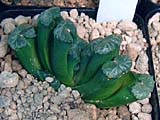
Photo 20. Haworthia. truncata cv. 'Mia'
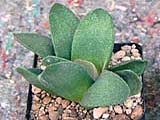
Photo 21. Gasterworthia cv. 'Flipper'
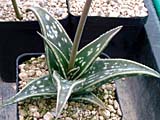
Photo 22. Aloe 'Jade temple'
| | | | | |





